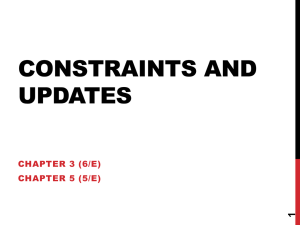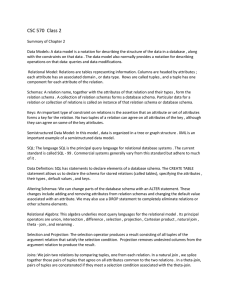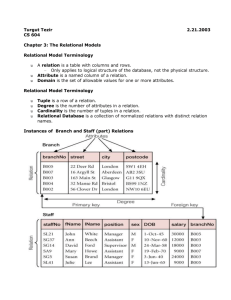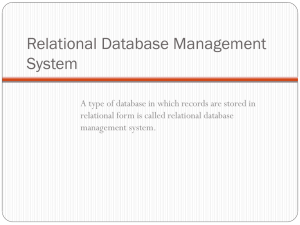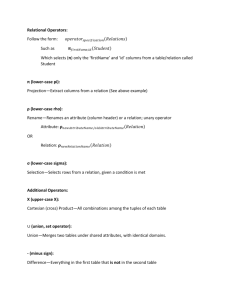reldb06.doc
advertisement
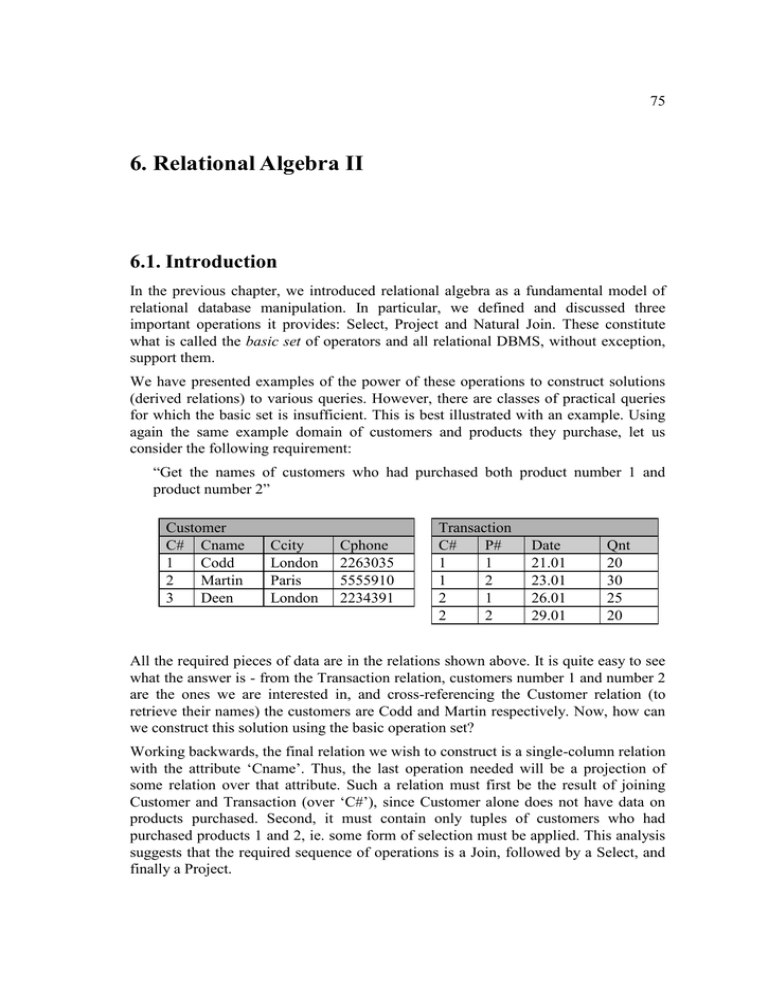
75
6. Relational Algebra II
6.1. Introduction
In the previous chapter, we introduced relational algebra as a fundamental model of
relational database manipulation. In particular, we defined and discussed three
important operations it provides: Select, Project and Natural Join. These constitute
what is called the basic set of operators and all relational DBMS, without exception,
support them.
We have presented examples of the power of these operations to construct solutions
(derived relations) to various queries. However, there are classes of practical queries
for which the basic set is insufficient. This is best illustrated with an example. Using
again the same example domain of customers and products they purchase, let us
consider the following requirement:
“Get the names of customers who had purchased both product number 1 and
product number 2”
Customer
C# Cname
1
Codd
2
Martin
3
Deen
Ccity
London
Paris
London
Cphone
2263035
5555910
2234391
Transaction
C#
P#
1
1
1
2
2
1
2
2
Date
21.01
23.01
26.01
29.01
Qnt
20
30
25
20
All the required pieces of data are in the relations shown above. It is quite easy to see
what the answer is - from the Transaction relation, customers number 1 and number 2
are the ones we are interested in, and cross-referencing the Customer relation (to
retrieve their names) the customers are Codd and Martin respectively. Now, how can
we construct this solution using the basic operation set?
Working backwards, the final relation we wish to construct is a single-column relation
with the attribute ‘Cname’. Thus, the last operation needed will be a projection of
some relation over that attribute. Such a relation must first be the result of joining
Customer and Transaction (over ‘C#’), since Customer alone does not have data on
products purchased. Second, it must contain only tuples of customers who had
purchased products 1 and 2, ie. some form of selection must be applied. This analysis
suggests that the required sequence of operations is a Join, followed by a Select, and
finally a Project.
76
6. Relational Algebra II
The following then may be a possible solution:
join Customer AND Transaction over C# giving A
select A where P# = 1 AND P# = 2 giving B
project B over Cname giving Result
The join results in:
A
C#
1
1
2
2
Cname
Codd
Codd
Martin
Martin
Ccity
London
London
Paris
Paris
Cphone
2263035
2263035
5555910
5555910
P#
1
2
1
2
Date
21.01
23.01
26.01
29.01
Qnt
20
30
25
20
At this point, however, we discover a problem: the selection on A results in an empty
relation!
The problem is the selection condition: no tuple can possibly satisfy a condition that
requires a single attribute to have two different values (“P# = 1 AND P# = 2”). This is
obvious once it is pointed out, although it might not have been so at first glance. Thus
while the selection statement is syntactically correct, its logic is erroneous. What is
needed, effectively, is to select tuples of a particular customer only if there exists one
with P# = 1 and another with P# = 2, ie. the form of selection needed is dependent
across tuples. But the basic Select operator cannot express this because it operates on
each tuple in turn and independently of one another.1
Thus the proposed solution above is not a solution at all. In fact, no combination of
the basic operations can handle the query or other queries of this sort, for example:
“Get the names of customers who bought the product CPU but not the product VDU”,
or
“Get the names of customers who bought every product type that the company sells”,
etc.
These examples suggest that additional operations are needed. In the following, we
shall present them and show how they are used.
1
Some readers may have noted that if OR was used instead of AND in the selection
operation, the desired result would be constructed. However, this is coincidental. The use of
OR is logically erroneous—it means one or the other, but not necessarily both. To see this,
change the example slightly by deleting the last tuple in Transaction and recompute the result
(using OR). Your answer would still be Codd and Martin, but the correct answer should be
Codd alone!
6. Relational Algebra II
77
We will round up this chapter and our discussion of relational algebra with a
discussion of two other important topics: how operations handle “null” values, and
how sequences of operations can be optimised for performance.
A null value is inserted into a tuple field to denote an (as yet) unknown value. Clearly,
this affects the evaluation of conditions involving attribute values. Exactly how will
be explained in Section 6.4. Finally, we will see that there may be several different
sequences of operations that derive the same result. In such cases, we may well ask
which sequence is more efficient, ie. least costly or better in performance, in some
sense. A more precise notion of ‘efficiency’ of operators and how a given operator
sequence can be made more efficient will be discussed in section 6.5.
6.2. Division
As the name of this operation implies, it involves dividing one relation by another.
Division is in principle a partitioning operation. Thus, 6 2 can be paraphrased as
partitioning a single group of 6 into a number of groups of 2 - in this case, 3 groups of
2. The basic terminology used in arithmetic will be used here as well. Thus in an
expression like x y, x is the dividend and y the divisor. Division does not always
yield whole groups of the divisor, eg. 7 2 gives 3 groups of 2 and a remainder group
of 1. Relational division too can leave remainders but, much like integer division, we
ignore remainders and focus only on constructing whole groups of the divisor.
The manner in which a relational dividend is partitioned is a little more complex. First
though, we should ask what aspect of a relation is being partitioned? The answer
simply is the set of tuples in the relation. Next, we ask how we decide to group some
tuples together and not others? Not surprisingly, the basis for such decisions has to do
with the attribute values in the tuples. Let’s take a look at an example first before we
describe the process more precisely.
R
A1
1
1
2
2
2
3
A2
a
b
c
b
a
c
/{a,b}
R’
A1
1
1
2
2
A2
a
b
a
b
Result
A1
1
2
The illustration above shows how we may divide a relation R, which is a simple
binary relation in this case with two attributes A1 and A2. For clarity, the values of
attribute A1 have been sorted so that a given value appears in contiguous rows (where
there’s more than one). The question we’re interested in is which of these values have
in common an arbitrary subset of values of attribute A2.
78
6. Relational Algebra II
For example,
“which values of A1 share the subset {a,b} of A2?”
By inspecting R, the reader can verify that the answer are the values 1 and 2, because
only tuples with these A1values have corresponding A2 entries of both ‘a’ and ‘b’. Put
another way, the tuples of R are grouped by the common denominator or divisor
{a,b}. This is shown in the relation R’ where we emphasise the groups formed using
double-line borders. Other tuples (the remainder of the division) are ignored. Note that
R’ is not the final result of division - it is only an intermediate working result. The
desired result are the values of attribute A1 in it, or put another way, the projection of
R’ over A1.
From this example, we can see that a division of a relation R is performed over some
attribute of R. The divisor is a subset of values from that attribute domain and the
result is a relation comprising the remaining attributes of R. In relational algebra
expessions, the divisor is in fact specified by another relation D. For this to be
meaningful at all, D must have at least one attribute in common with the R. The
division is over the common attribute(s) and the set of values used as the actual
divisor are the values found in D. The general operation is depicted in the figure
below.
Figure 6-1. The Division Operation
Figure 6-2 shows a simple example of dividing a binary relation R1 by a unary
relation R2. The division is over the shared attribute I2. The divisor is the set {1,2,3},
these being the values found in the shared attribute in R2. Inspecting the tuples of R1,
the value ‘a’ occur in tuples such that their I2 values match the divisor. So ‘a’ is
included in the result. ‘b’ is not, however, as there is no tuple <b,2>.
6. Relational Algebra II
79
Figure 6-2 Division of a binary relation by a unary relation
We can now specify the form of the operation:
divide <dividend-relation-name> by <divisor-relation-name>
giving <result-relation-name>
<dividend-relation-name> and <divisor-relation-name> must be names of defined
relations or results of previous operations. <result-relation-name> must be a unique
name used to denote the result relation. As mentioned above, the divisor must share
attributes with the dividend. In fact, we shall insist (on a stronger condition) that the
intension of the divisor must be a subset of the dividend’s. This is not really a
restriction as any relation that shares attributes with the dividend can be turned into
the required form simply by projecting over them.
We can now show how division can be used for the type of queries mentioned in the
introduction. Take the query:
“Get the names of customers who bought every product type that the company sells”
The Transaction relation records customers who have ever bought anything. For this
query, however, we are not interested in the dates or purchase quantities but only in
the product types a customer purchased. So we project Transaction over C# and P# to
give us a working relation A. This is shown on the left side of the following
illustration. Next, we need all the product types the company sells, and these may be
obtained by projecting the relation Product over P# to give us a working relation B.
This is shown on the right side of the illustration.
80
6. Relational Algebra II
Transaction
C#
P#
1
1
1
2
2
1
3
2
Date
21.01
23.01
26.01
29.01
Qnt
20
30
25
20
Product
P#
1
2
Pname
CPU
VDU
project Product
over P# giving B
project Transaction
over C#, P# giving A
A
C#
1
1
P#
1
2
2
3
1
2
B
P#
1
2
divide A by B
giving C
Now as we are interested in only those customers
that purchased all products (ie. all the values in B), B
is thus used to divide A to result in the working
relation C. In this case, there is only one such
customer. Finally, the details of the customer are
obtained by joining C with the Customer relation
over C#.
Customer
C# Cname
1
Codd
2
Martin
3
Deen
C
Ccity
London
Paris
London
Cphone
2263035
5555910
2234391
join Customer, C
over C# giving
Result
Result
C# Cname
1
Codd
Ccity
London
Cphone
2263035
Pprice
1000
1200
C#
1
6. Relational Algebra II
81
Formal Definition
To formally define the Divide operation, we will use the notation introduced and used
in Chapter 5. However, for convenience, we repeat here principal definitions to be
used.
If denotes a relation, then let
S() denote the finite set of attribute names of (ie. its intension)
T() denote the finite set of tuples of (ie. its extension)
, where T() and S(), denote the value of attribute in tuple
Stuple(x) denote the set of elements in tuple x
Furthermore, if T(), ’ denotes a tuple, and Stuple() S(), we define:
R(, , ’) Stuple() Stuple(’)
The Divide operation takes the form
divide by giving
As with other operations, the input sources and must denote valid relations that
are either defined in the schema or are results of previous operations, and must be a
unique identifier to denote the result of the division. The intensions of and must
be such that
S() S()
The Divide operation can then be characterised by the following:
S() S() – S()
T() { | 1 T() R(1,,) T() IM() }
where
Stuple() = S(),
Stuple() = S(), and
IM() = { t’ | t T() R(t, , t’) R(t, , ) }
6.3. Set Operations
Relations are basically sets. We should, therefore, be able to apply standard set
operations on them. To do this, however, we must observe a basic rule: a set operation
on two or more sets is meaningful if the sets comprise values of the same type. This is
so that comparison of values from different sets is meaningful. It is quite pointless, for
example, to attempt an intersection of a set of integers and a set of names. We can still
perform the operation, of course, but we can already tell at the outset that the result
will be a null set because any value from one will never be equal to any value from the
other.
To ensure this rule is observed for relations, we need to state what it means for two
relations to comprise values of the same type. As a relation is a set of tuples, the
82
6. Relational Algebra II
values we are interested in are the tuples themselves. So when is it meaningful to
compare two tuples for equality? Clearly, the structure of the tuples must be identical,
ie. the tuples must be of equal length and their corresponding elements must be of the
same type. Only then can two tuples be equal, ie. when their corresponding element
values are equal. The structure of a tuple, put another way, is in fact the intension or
schema of the relation it occurs in. Thus, meaningful set operations on relations
require that the source relations have identical intensions/schemas. Such relations are
said to be union-compatible.
The set operations included in relational algebra are Union, Intersection, and
Difference. Keeping in mind that they are applied to whole tuples, these operations
behave in exactly the standard way. It goes without saying that their results are also
relations with intensions identical to the source relations.
The Union operation takes the form
<source-relation-1> union <source-relation-2> giving <result-relation>
where <source-relation-i> are valid relations or results of previous operations and are
union-compatible, and <result-relation> is a unique identifier denoting the resulting
relation.
Figure 6-3 illustrates this operation.
Figure 6-3 Relational Union Operation
The Intersection operation takes the form
6. Relational Algebra II
83
<source-relation-1> intersect <source-relation-2> giving <result-relation>
where <source-relation-i> are valid relations or results of previous operations and are
union-compatible, and <result-relation> is a unique identifier denoting the resulting
relation.
Figure 6-4 illustrate this operation.
Figure 6-4 Relational Intersection Operation
The Difference operation takes the form
<source-relation-1> minus <source-relation-2> giving <result-relation>
where <source-relation-i> are valid relations or results of previous operations and are
union-compatible, and <result-relation> is a unique identifier denoting the resulting
relation.
Figure 6-5 illustrate this operation.
Figure 6-5 Relational Difference Operation
As an example of the need for set operations, consider the query: “which customers
purchased the product CPU but not the product VDU?”
84
6. Relational Algebra II
The sequence of operations to answer this question is quite lengthy, but not difficult.
Probably the best way to construct a solution is to work backwards and observe that if
we had a set of customers who purchased CPU (say W1) and another set of customers
who purchased VDU (say W2), then the solution is obvious: we only want customers
that appear in W1 but not in W2, or in other words, the operation “W1 minus W2”.
The problem now has been reduced to constructing the sets W1 and W2. Their
constructions are similar, the difference being that one focuses on the product CPU
while the other the product VDU. We show the construction for W1 below.
Transaction
C#
P#
1
1
1
2
2
1
3
2
Date
21.01
23.01
26.01
29.01
Product
P#
Pname Pprice
1
CPU
1000
2
VDU 1200
Qnt
20
30
25
20
join Transaction AND Product over P# giving X
X
C#
1
1
2
3
P#
1
2
1
2
Date
21.01
23.01
26.01
29.01
Qnt
20
30
25
20
The above Join operation is
needed to bring in the product
name into the resulting relation.
This is then used as the basis of a
selection, as shown on the right.
Y1
C#
1
2
P#
1
1
Date
21.01
26.01
Qnt
20
25
Pname
CPU
VDU
CPU
VDU
Pprice
1000
1200
1000
1200
select X where Pname = CPU giving
Y1
Pname
CPU
CPU
Pprice
1000
1000
Y1 now has only customer numbers that
purchased the product CPU. As we are interested
project Y1 over C# giving Z1
only in the customers and not other details, we
perform the projection on the right.
Customer
Z1
6. Relational Algebra II
C#
1
2
3
Cname
Codd
Martin
Deen
Ccity
London
Paris
London
Cphone
2263035
5555910
2234391
85
C#
1
2
join Customer AND Z1 over C# giving W1
Finally, details of such
customers are obtained by
joining Z1 and Customer,
giving the desired relation
W1.
W1
C#
1
2
Cname Ccity
Codd
London
Martin Paris
Cphone
2263035
5555910
The construction for W2 is practically identical to that above except that the selection
operation specifies the condition “Pname = VDU”. The reader may like to perform
these steps as an exercise and verify that the following relation is obtained:
W2
C#
1
3
Cname Ccity
Codd
London
Deen
London
Cphone
2263035
2234391
Now we need only perform the difference operation “W1 minus W2 giving Result”
to construct a solution to the query:
Result
C#
Cname Ccity
2
Martin Paris
Cphone
5555910
Formal Definition
If denotes a relation, then let
S() denote the finite set of attribute names of (ie. its intension)
T() denote the finite set of tuples of (ie. its extension)
The form of set operations is
<set operator> giving
where <set operator> is one of ‘union’, ‘intersect’ or ‘minus’; , are source relations
and the result relation. The source relations must be union-compatible, ie. S() =
S().
86
6. Relational Algebra II
The set operations are characterised by the following:
S() = S() = S() for all <set operator>s
for ‘union’
T() { t | t T() t T() }
for ‘intersect’
T() { t | t T() t T() }
for ‘minus’
T() { t | t T() t T() }
6.4. Null values
In populating a database with data objects, it is not uncommon that some of these
objects may not be completely known. For example, in capturing new customer
information through forms that customers are requested to fill, some fields may have
been left blank (some customers may take exception to revealing their age or phone
numbers!). In these cases, rather than not have any information at all, we can still
record those that we know about. But what value do we insert into the unknown fields
of data objects? Leaving a field blank is not good enough as it can be interpreted as an
empty string which may be a valid value for some domains. We need a value that
denotes ‘unknown’ and that cannot be confused with valid domain values.
It is here that the Null value is used. We can think of it as a special value different
from any other value from any attribute domain. At the same time, we may think of it
as belonging to every attribute domain in the database, ie. it may appear as a value for
any attribute and not violate any type constraints. Syntactically, different DBMSs may
use different symbols to denote null values. For our purposes, we will use the symbol
‘?’.
How do null values affect relational operations? All relational operations involve
comparing values in tuples, including Projection (which involves comparison of result
tuples for duplicates). The key to answering this question is in how we evaluate
boolean operations involving null values. Thus, for example, what does “? > 5”
evaluate to? The unknown value could be greater than 5. But then again, it may not
be. That is, the value of the boolean expression cannot be determined on the basis of
available information. So perhaps we should consider the result of the comparison as
unknown as well?
Unfortunately, if we did this, the relational operations we’ve discussed cease to be
well-defined! They all rely on comparisons evaluating categorically to one of two
values: TRUE or FALSE. For example, if the above comparison (“? > 5”) was
generated in the process of selection, we would not know whether to include or
exclude the associated tuple in the result if we were to admit a third value
(UNKNOWN). If we wanted to do that, we must go back and redefine all these
operations based on some form of three-valued logic.
6. Relational Algebra II
87
To avoid this problem, most systems that allow null values simply interpret any
comparison involving them as FALSE. The rationale is that even though they could be
true, they are not demonstrably true on the basis of what is known. That is, the result
of any relational operation conservatively includes only tuples that demonstrably
satisfy conditions of the operation. Adopting this convention, all the operations
defined previously still hold without any amendment. Some implications on the
outcome of each operation are considered below.
For the Select operation, an unknown value cannot identify a tuple. This is illustrated
in Figure 6-6 which shows two Select operations applied to the relation R. Note that
between the two operations, the selection criteria ranges over the entire domain of the
attribute I2. One would expect therefore, that any tuple in R1 would either be in the
result of the first or the second. This is not the case, however, as the second tuple in
R1 (<b,?>) is not selected in either operation—the unknown value in it falsifies the
selection criteria of both operations!
Figure 6-6 Selecting over null values
For Projection, tuples containing null values that are otherwise identical are not
considered to be duplicates. This is because the comparison “? = ?”, by the above
convention, evaluates to FALSE. This leads to the situation as illustrated in Figure 6-7
below. The reader should note from this example that the symbol ‘?’, while it denotes
some value much like a mathematical variable, is quite unlike the latter in that it’s
occurrences do not always denote the same value. Thus “? = ?” is not demonstrably
true and therefore considered FALSE.
Figure 6-7 Projecting over null values
88
6. Relational Algebra II
In a Join operation, tuples having null values under the common attributes are not
concatenated. This is illustrated in Figure 6-8 (“?=1”, “1=?” and “?=?” are all
FALSE).
Figure 6-8 Joining over null values
In Division, the occurrence of even one null value in the divisor means that the result
will be an empty relation, as any value in the dividend’s common attribute(s) will fail
when matched with it. This is illustrated in Figure 6-9 below. Note, however, that this
is not necessarily the case if only the dividend contains null values under the common
attribute(s) - division may still be successful on tuples not containing null values.
Figure 6-9 Division with null divisors
In set operations, because tuples are treated as a single unit in comparisons, a single
rule applies: tuples otherwise identical but containing null values are considered to be
different (as was the case for Projection above). Figure 6-10 illustrates this for each
set operation. Note that because of the occurrence of null values, the tuples in R2 are
not considered duplicates of R1’s tuples. Thus their union simply collects tuples from
both relations; subtracting R2 from R1 simply results in R1; and their intersection is
empty.
6. Relational Algebra II
89
Figure 6-10 Set operations involving null values
6.5. Optimisation
Each relational operation entails a certain amount of work: retrieving a tuple,
examining a tuple’s attribute values, comparing attribute values, creating new tuples,
repeating a process on each tuple in a relation, etc. For a given operation, the amount
of work clearly varies with the cardinality of source relation(s). For example, a
selection performed on a relation twice the cardinality of another (of the same degree)
would involve twice as much work.
We can also compare the relative amount of work needed between different
operations based on the number of tuples processed. An operation with two source
inputs, for example, need to repeat its logic on every possible tuple-pair formed by
taking a tuple from each input relation. Thus if we had two relations of cardinalities M
and N respectively, a total of MN tuple-pairs must be processed, ie. M (or N) times
more than, say, a selection operation on each individual relation. Of course, this is not
an exact relative measure of work, as there are also differences in the amount of work
expended by different operations at the tuple level. By and large, however, we are
interested in the order of magnitude of work (rather than the exact amount of work)
and this is fairly well approximated by the number of tuples processed.
We will call such a measure the efficiency of an operation. Thus, the efficiency of
selection and projection is the cardinality of its single input relation, while the
efficiency of join, divide and set operations is the product of the respective
cardinalities of their two input relations.
Why should the efficiency of operations interest us? Consider the following sequence
of operations:
join Customer AND Transaction over C# giving X;
select X where CCity = “London” giving Result
90
6. Relational Algebra II
Suppose the cardinality of Customer was 100 and that of Transaction was 1000. Then
the efficiency of the join operation is 1001000 = 100000. The cardinality of X is
1000 (as it is certainly intended that the C# in every Transaction tuple matches a C# in
one of the Customer tuples). Therefore, the efficiency of the selection is 1000. As
these two operations are performed one after another, the efficiency of the entire
sequence of operations is naturally the sum of their individual efficiencies, ie.
100000+1000 = 101000.
Now consider the following sequence:
select Customer where CCity = “London” giving X;
join X AND Transaction over C# giving Result
The reader can verify that this sequence is relationally equivalent to the first, ie. they
produce identical results. But how does its efficiency compare with that of the first?
Let us calculate using the same assumptions about the cardinalities. The efficiency of
the selection is 100. To estimate the efficiency of the join, we need to make an
assumption on the cardinality of X. Let’s say that 10 customers live in London. Then
the efficiency of the join is 101000 = 10000, and the efficiency of the sequence as a
whole is 100+10000 = 10100 - ten times more efficient than the first!
Of course, the reader may think that the assumption about X’s cardinality was
contrived to give this dramatic performance improvement. The point, however, is that
the second sequence can do no worse than the first, ie. if all customers in the
Customer relation live in London, then it performs as poorly as the first. More likely,
however, we expect a performance improvement.
The above example illustrates a very important point about relational algebra: there
can be more than one (sequence of) expression that describe a desired result. The main
aim of optimisation, therefore, is to translate a given (sequence of) expression into its
most efficient equivalent form. Such optimisation may be done manually by a human
user or automatically by the database management system. Automatic optimisation
may in fact do better because the automatic optimiser has access to information that is
not readily available to a human optimiser, eg. current cardinalities of source relations,
current data values, etc. But the overwhelming majority of relational DBMS’s
available today merely execute operations requested by users as is. Thus, it is
important that users know how to perform optimisations manually.
For manual optimisation, it is perhaps less important to derive the most efficient form
of a query than to follow certain guidelines, heuristics or rules-of-thumb that lead to
more efficient expressions. Frequently the latter will lead to acceptable performance
and expending more effort to find the optimal expression may not significantly
improve that performance if good heuristics are used. There is, in fact, a simple and
effective rule to remember when writing queries: delay as long as possible the use of
expensive operations! In particular, we should wherever possible put selection ahead
of other operations because it reduces the cardinality of relations. Figure 6-11
illustrate the application of this principle. The reader should be able to verify that the
6. Relational Algebra II
91
two sequences of operations are logically equivalent and that intuitively the selection
operations before the joins can significantly improve the efficiency of the query.
Figure 6-11 Delay expensive operations
